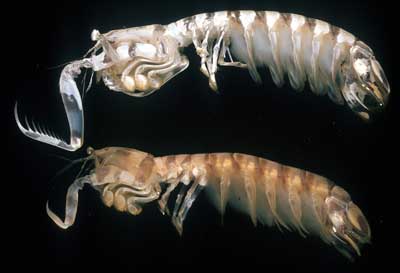




Adult pair of Lysiasquilla maculata. Image provided with permission from Roy Caldwell, U.C. Berkeley.
Stomatopods are amazing animals to watch go about their daily lives. They have large stalked compound eyes that are capable of very complex vision and can be seen constantly moving, watching you in return. They live in crevices or in borrows that they build themselves. Stomatopods are surprisingly agile and can change direction in their burrows. When startled they often dart into their burrows head first and quickly re-appear head up in the burrow, ready to defend it. Most stomatopods are found in shallow tropical or subtropical marine habitats.
Stomatopods are raptorial predators that feed on fish, molluscs, cnidarians, and other crustaceans. They are one of the few predators on the deadly blue-ring octopus, which incidently, also eats stomatopods. Once a food item is captured by quick stab or smash of the second thoracopods, it is handled with the other four pairs of thoracic appendages which are subchelate (grasping, pincer-like). All five pairs of thoracic appendages involved in feeding are called maxillipeds and are also used in building burrows. The last three pairs of thoracic appendages are used for walking.
Visit the UCMP special exhibit Secrets of the Stomatopod: An Underwater Research Adventure to learn more about some of the unique features of stomatopods, and about a 2001 research expedition to study stomatopods in their own habitat.
